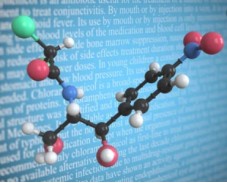
Chloramphenicol (CAP) is a highly effective broad-spectrum antibacterial agent with spinogenic activity, which is effective in agricultural production for treating diseases caused by pathogenic gram-negative bacteria suffered by livestock and poultry and aquatic organisms, and it has a good therapeutic effect on salmonellosis and colibacillosis. However, with wide application, it was found that chloramphenicol can cause a reduction of various types of blood cells, such as thrombocytopenic purpura and granulocyte deficiency, through short-term reversible myelosuppression. In severe cases, chloramphenicol can cause irreversible aplastic anemia; patients rarely recover hematopoietic function, although the occurrence of late but high mortality, and survivors are also prone to agranulocytic leukemia. Lifeasible can provide customers with chloramphenicol testing for mollusks, data analysis, and conduct risk assessment services.
In the EU regulation (EEC) No. 2377/90 and subsequent versions of the limits, chloramphenicol is listed among the substances for which no residue limits are established (banned). The minimum enforcement limit (MRPL) for chloramphenicol residues in fish is 0.3 μg-kg-1 in the Official Journal of the European Commission Resolution 2003/181/EC and in the specifications of the Global Aquaculture Alliance (GAA).
Lifeasible can determine chloramphenicol in mollusks by liquid chromatography-tandem mass spectrometry. The determination is performed with internal quality control using blank experiments, parallel double sampling, quality control sample determination, and positive retesting.
The volume fraction of chloramphenicol in the test solution was obtained by the standard curve method, and the residue of chloramphenicol in shellfish products X=cV/m, c is the volume fraction of chloramphenicol in the test solution, V is the volume used to dissolve the residue, and m is the mass of shellfish samples.
Distribution fitting of chloramphenicol mass fraction data in mollusks. The software was used to fit the distribution of the chloramphenicol mass fraction detected values in mollusks.
Exposure Boundary Ratio Assessment. The risk characterization of chloramphenicol residues in commercially available shellfish products was performed using the MOE method, a genotoxic carcinogen risk assessment technique. The MOE values of P50 and P95 were evaluated by referring to the MOE results, i.e., MOE values <5,000, 5,000~500,000, and >500,000 indicated that the estimated hazards were high, medium, and low levels, respectively.
Health risk assessment is a method or tool for describing and assessing the likelihood of a particular disease occurring in the future in an individual or death due to a particular disease. The risk to humans is analyzed by testing for chloramphenicol and then conducting a risk assessment.
If you are interested in our services, or if the service you want is not listed, please feel free to contact us, and we will get back to you as soon as possible.
Lifeasible has established a one-stop service platform for plants. In addition to obtaining customized solutions for plant genetic engineering, customers can also conduct follow-up analysis and research on plants through our analysis platform. The analytical services we provide include but are not limited to the following:
Get Latest Lifeasible News and Updates Directly to Your Inbox
Adaptive Evolutionary Mechanism of Plants
February 28, 2025
Unraveling Cotton Development: Insights from Multi-Omics Studies
February 27, 2025